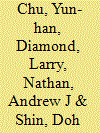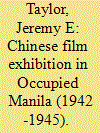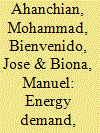|
|
|
Sort Order |
|
|
|
Items / Page
|
|
|
|
|
|
|
| Srl | Item |
| 1 |
ID:
086348


|
|
|
|
|
| Publication |
2009.
|
| Summary/Abstract |
East Asian democracies are in distress. From Bangkok to Manila to Taipei to Seoul to Ulaanbaatar, democratically elected governments in the last few years have suffered inconclusive or disputed electoral outcomes, political strife, partisan gridlock, and recurring political scandals. In 2006-2007, frustrated citizens in Manila and Taipei lost confidence in democratic procedures to the point where they tried to bring down incumbent leaders through extraconstitutional demonstrations, while a crippling political crisis in Thailand in 2006 triggered a military coup.
|
|
|
|
|
|
|
|
|
|
|
|
|
|
|
|
| 2 |
ID:
126139


|
|
|
|
|
| Publication |
2013.
|
| Summary/Abstract |
This paper explores the nature of film exhibition amongst the Chinese community in Manila during the Japanese Occupation of that city. Based on advertisements and film listings published in the Chinese-language press of the day (as well as on pre-war records concerning commercial Chinese entertainment in the Philippines), it explores the continuities in film exhibition practice undertaken by various theatre operators within the Binondo area of Manila both before, during, and after the war. The paper suggests not only that such practices represented a quite different trajectory from that experienced in other parts of Occupied Manila, but also that a more thorough exploration of the Manila Chinese during wartime-one which goes beyond questions of mere collaboration and/or resistance-will encourage us to question some of the assumptions that underpin recent scholarship about this community.
|
|
|
|
|
|
|
|
|
|
|
|
|
|
|
|
| 3 |
ID:
128046


|
|
|
|
|
| Publication |
2014.
|
| Summary/Abstract |
Transportation contributes to resource depletion and has other negative impacts on the environment. The present study presents models of energy demand and environmental emissions for the land transportation sector in Metro Manila, Philippines from 2010 to 2040 using the "Long Range Energy Alternatives Planning (LEAP)" tool. The study projected energy demand and CO2, CO, HC, NOx and PM10 emissions for Business-As-Usual (BAU) and alternative scenarios and compared the results while aiming to determine optimal transportation policies to reduce energy demand and emissions. The results indicated that the adoption of EURO 4 emission standards provides the greatest reduction in energy use at 10.8%, while the best cases for the various gas emissions were split among different options. In addition, a combination of all of the alternatives is expected to lower energy use by 27.8% and to reduce CO2, CO, HC, NOx and PM10 by 30.3%, 60.3%, 59.0%, 48.2% and 66.4%, respectively. The analytical framework employed herein could be applied to other cities to evaluate and prioritize strategies to reduce future energy requirements and emissions.
|
|
|
|
|
|
|
|
|
|
|
|
|
|
|
|
| 4 |
ID:
178509


|
|
|
|
|
| Summary/Abstract |
This article focuses on how political agendas and existing societal circumstances in three Southeast Asian regions impacted the early history of immigrant Hokkiens, one of the most prominent Chinese ethnic groups. The article argues that different Hokkien actions and their outcomes were shaped or highly influenced by the prevailing agenda and political struggles of local rulers and/or colonial powers, resulting in selective adaptive behaviour as ‘challengers’ or ‘cooperators’. There were prominent immigrant Hokkien challengers to the status quo in Manila and elsewhere in the Philippine Islands, but both cooperators with the prevailing status quo and challengers to it were common in Hoi An, Vietnam. By contrast, cooperators were conspicuous in Batavia and in the colonial Dutch East Indies.
|
|
|
|
|
|
|
|
|
|
|
|
|
|
|
|
| 5 |
ID:
118903


|
|
|
|
|
| Publication |
2012.
|
| Summary/Abstract |
From the late nineteenth century onwards, a new range of European and American technologies, powered by electricity and gas, and intended for use on the body and in the home-especially appliances for the domestic kitchen-began to appear in Manila. Electro-mechanical vibratory devices and steam-powered massagers for the body; hair waving and curling machines; and a multitude of technologies for the domestic kitchen, from stoves and water heaters to a gamut of electric and gas gadgetry that included percolators, boilers, electric waffle-irons, grills, and refrigerators (or ice-boxes, their precursor) were targeted largely at the affluent female consumer with promises to improve her physical appearance and health or make her daily life more comfortable. Their introduction and impact in the Philippines can tell a number of compelling stories-the desirability of European or American bourgeois culture, how the trappings of Western lifestyles were imagined, the extent to which the use and purchase of certain technologies aimed at replicating or emulating those lifestyles, or, as this paper explores, the gendered technological infrastructure of the 'good life'. In this story, modern technologies designed for domestic settings and for use on women's bodies made manifest a myriad of desires and aspirations-prestige, status, cosmopolitanism, modernity, and urbanity. They also articulated a particular sensuousness and pleasure. Electro-vibratory devices, hair styling machines, and kitchen appliances could be experienced by all the senses and thus exerted a visceral appeal; their use proclaimed an enthusiasm for modern technology which, for the first time, emphasized the relevance of modern technology to women's everyday lives by the transformative effects they promised.
|
|
|
|
|
|
|
|
|
|
|
|
|
|
|
|
| 6 |
ID:
100568


|
|
|
|
|
| Publication |
2011.
|
| Summary/Abstract |
Discussion of the political impact of social media has focused on the power of mass protests to topple governments. In fact, social media's real potential lies in supporting civil society and the public sphere -- which will produce change over years and decades, not weeks or months.
|
|
|
|
|
|
|
|
|
|
|
|
|
|
|
|
|
|
|
|
|